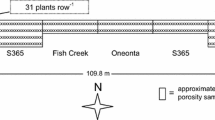Abstract
On the Canadian Prairies and the northern US Great Plains, snow is an important component of annual precipitation, sometimes constituting over 40% of the total, although there is much annual and regional variability. Much of this snow is transported by wind, causing substantial sublimation losses, which are reduced by obstacles and topographic features on the landscape that reduce snow transport and trap snow. Agroforestry configurations trap snow and reduce the amount and distance of snow movement and, because of this, reduce the amount of moisture lost to sublimation. The planning of agroforestry measures should therefore take into account their effects on snow hydrology. In this study, the effects of shelterbelts on snow quantity and distribution are shown over multiple years, including a number of locations in Manitoba and Saskatchewan. Results show that snow transport reached equilibrium in 400 m or less (i.e., that sublimation rates were at their maximum beyond 400 m leeward of a shelterbelt). Also, in a paired landscape inventory, the landscape with shelterbelts had 29% more snow water equivalent (SWE) than the unsheltered landscape. Site-specific meteorological data was used in the Prairie Blowing Snow Model, now a component of the Cold Regions Hydrological Model, to calculate the effects of agroforestry configurations on snow water conservation. Modeled snow distribution agreed well with measured snow at Conquest, Saskatchewan, in the winter of 2009/2010. Using actual weather data for the same location for the period 1996–2011, the model calculated the annual sublimation from 200 m wide fields protected by shelterbelts to be up to 12.5 mm less than similar unsheltered fields.









Similar content being viewed by others
References
Aase JK, Siddoway FH, Black AL (1976) Perennial grass barriers for wind erosion control, snow management and crop protection. In: Tinus RW (ed) Shelterbelts on the Great Plains. Great Plains Agricultural Council Publication No. 78, pp 68–70
Annandale JG, Jovanovic NZ, Benadé N, Allen RG (2002) Software for missing data error analysis of Penman-Monteith reference evapotranspiration. Irrig Sci 21:57–67
Fang X, Pomeroy JW (2009) Modelling blowing snow redistribution to prairie wetlands. Hydrol Process 23:2557–2569
Greb BW (1980) Snowfall and its potential management in the semiarid Central Great Plains. USDA Science and Education Administration ARM-W-18, 46 pp
Haehnel RB, Liston G (2004) GIS-based three-dimensional snow drift computer model. In: Proceedings of the sixth international symposium on snow removal and ice control technology, Spokane, June 7–9, 2004. Published by the Transportation Research Board. ISSN: 0097-8515, Issue# E-C063, pp 625–635
Kort J (1988) Benefits of windbreaks to field and forage crops. Agric Ecosyst Environ 22(23):165–190
Pomeroy JW, Gray DM (1995) Snowcover: accumulation, relocation and management. NHRI Science Report No. 7. National Hydrology Research Institute, Saskatoon. ISBN 0-660-15816-7
Pomeroy JW, Li L (2000) Prairie and Arctic areal snow cover mass balance using a blowing snow model. J Geophys Res 105:26619–26634
Pomeroy JW, Gray DM, Brown T, Hedstrom NR, Quinton W, Granger RJ, Carey S (2007) The cold regions hydrological model: a platform for basing process representation and model structure on physical evidence. Hydrol Process 21:2650–2667
Scholten H (1988) Snow distribution on crop fields. Agric Ecosyst Environ 22(23):363–380
Shaw DL (1988) The design and use of living snow fences in North America. Agric Ecosyst Environ 22(23):351–362
Tabler RD (1994) Design guidelines for the control of blowing and drifting snow. Strategic Highway Research Program, National Research Council. Washington. ISBN 0-309-05758-2
Author information
Authors and Affiliations
Corresponding author
Rights and permissions
About this article
Cite this article
Kort, J., Bank, G., Pomeroy, J. et al. Effects of shelterbelts on snow distribution and sublimation. Agroforest Syst 86, 335–344 (2012). https://doi.org/10.1007/s10457-011-9466-4
Received:
Accepted:
Published:
Issue Date:
DOI: https://doi.org/10.1007/s10457-011-9466-4




